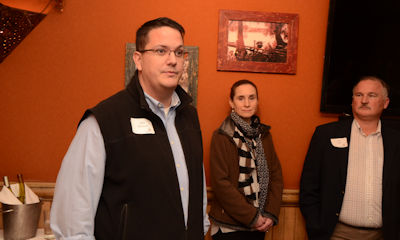
Earlier this week at the 2016 Commodity Classic in New Orleans, the Environmental Defense Fund (EDF) launched NutrientStar, an independent, science-based program that reviews the performance of commercially available nutrient management tools.
Nitrogen is one of the most important inputs in agriculture – fertilizer makes up about half of farmers' input costs each year. However, according to research by Cliff Snyder, nitrogen program director at the International Plant Nutrition Institute based in Conway, Arkansas, up to 40% to 60% of nitrogen applied is not absorbed by crops – increasing risk of air and water pollution and wasting farmers' money.

FIELD TESTED: John McGuire (left), Suzy Friedman, and Fred Yoder. McGuire explains the NutrientStar program will work by conducting field trials over two years from a number of locations. "We're looking at subsetting by environment, by local agro-ecoregions," he says. "We're able to say if I conduct a trial here, it has validity over this geography because of the conditions that persist in that area. There will be aggregation but there will also be segmentation by those regions."
Meanwhile, companies at the food/grocery retail level are launching sustainable sourcing programs, calling on farmers to improve fertilizer efficiency and other sustainability metrics to improve air and water quality while maintaining the productivity needed to feed a growing population.
In the last several years, a number of products, tools, and practices related to nutrient management have surfaced with claims of reducing fertilizer loss, improving soil health, reducing input costs, and maintaining or improving yields in a way that can help meet this demand. NutrientStar's aim is to showcase how well these products actually work in real-world farming scenarios, giving farmers confidence in knowing which tools work as advertised.
"The goal of NutrientStar is to bring more information and transparency about the effectiveness of nutrient use efficiency technologies and products to farmers and their advisors so they can make more informed decisions about which are likely to work for their farm and which are worth investing in. Farmers not only face economic pressures to use their inputs more efficiently, but also pressure from the supply chain to become more sustainable and pressure from regulators, water users, and communities to improve water quality," says Suzy Friedman, director of the ag sustainability program at EDF.
Testing in an on-farm setting
How does the program work? A review panel of fertilizer management experts, including USDA scientists and researchers at land grant universities from across the U.S., will conduct assessments of various tools on the market in an on-farm setting.
"We wanted the review panel members to be unbiased and independent," says Karen Chapman, agricultural sustainability project manager at EDF and administrator of the NutrientStar program. "They don't have a [vested] interest in any of the tools and technologies we are looking at and can't be developing any of them on their own."
John McGuire, EDF advisor and precision agriculture expert, explains these experts have also helped establish a common set of standards for research. This way, these scientists conduct field trials using consistent protocol, with randomization and replication. The program will work by conducting field trials over two years from a number of locations.
"We're looking at subsetting by environment, by local agro-ecoregions," McGuire says. "We're able to say if I conduct a trial here, it has validity over this geography because of the conditions that persist in that area. There will be aggregation but there will also be segmentation by those regions."
Fertilizer management tools soon to be evaluated through NutrientStar include enhanced efficiency fertilizer compounds like nitrogen stabilizers, and decision support tools like optical sensors or models used to aid nutrient applications in the field.
Information from these assessments will be available on the NutrientStar website, www.nutrientstar.org, and broken down by efficiency and effectiveness under certain conditions and in specific regions.
Filling an important need
Fred Yoder, chairman of the North American Climate Smart Ag Alliance who farms in west central Ohio, notes especially with tighter margins, there's a big need to fill with a program like NutrientStar.
"I look at this like show me the Carfax. Show me what's really working – something that you can trust and agree that it's going to make your operation better," Yoder says. On the other side, there's also a need for a tool to demonstrate sustainability through the supply chain. "The supply chain is looking for proof we're actually changing out there. We need proof that these things are working on the farm and qualify as a sustainable supply chain."
Brent Bible, who farms in west central Indiana, notes when margins are tight and it's difficult to make decisions on spending extra dollars on products, it's important to have the confidence to know whether those products are making a difference.
"Three to five years ago it was very easy to try the next neat product. We had great margins we were making money profitability was over the top and it was easy to spend a few thousand dollars extra to try the next snake oil that came along. It was okay to throw what I'll call play money at some of those neat ideas. Those days are over," Bible says. "That was a profitability cycle. We're now in the cycle of being a lot more conscientious of our input costs, of what the return is for that dollar spent."
For more information, visit www.nutrientstar.org.
About the Author(s)
You May Also Like






